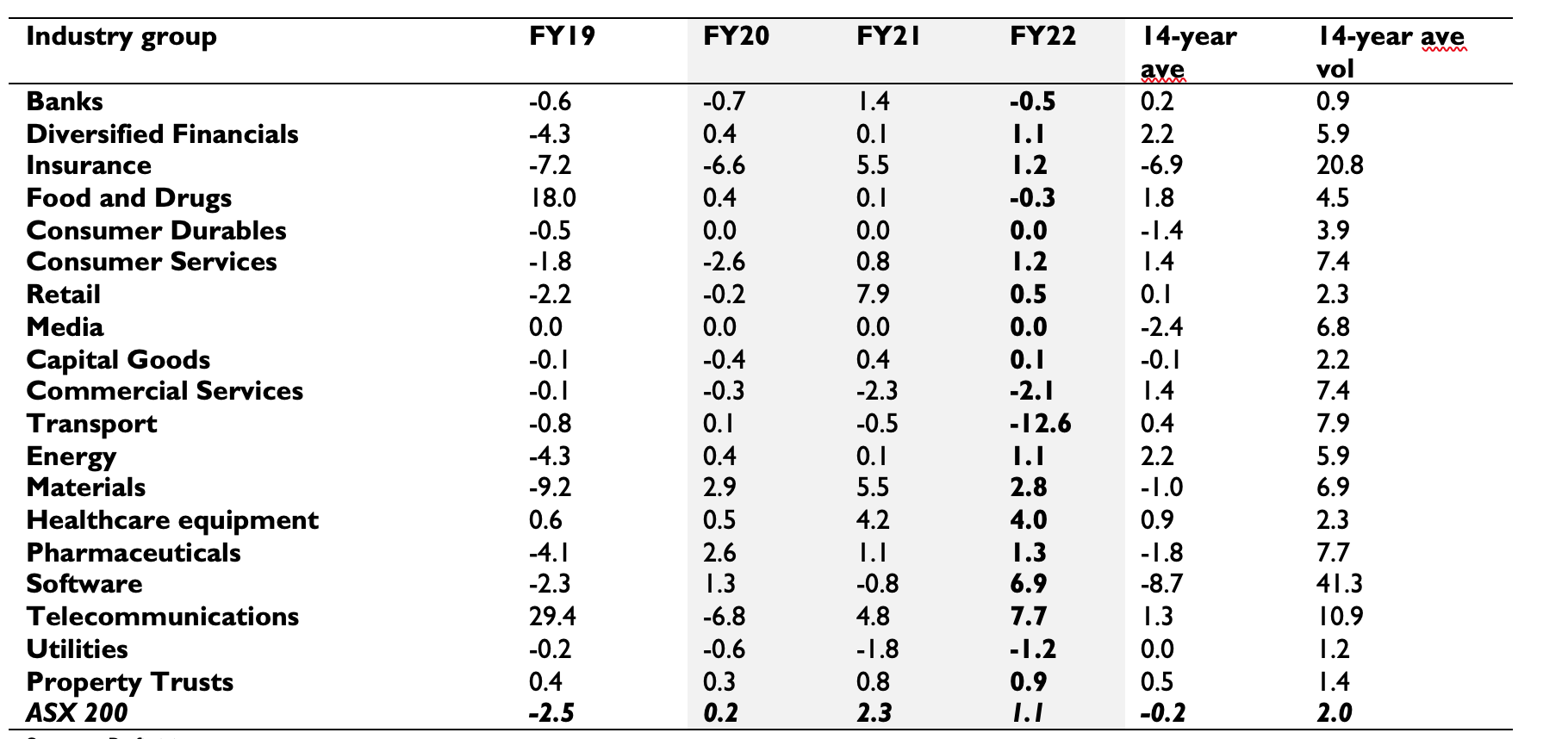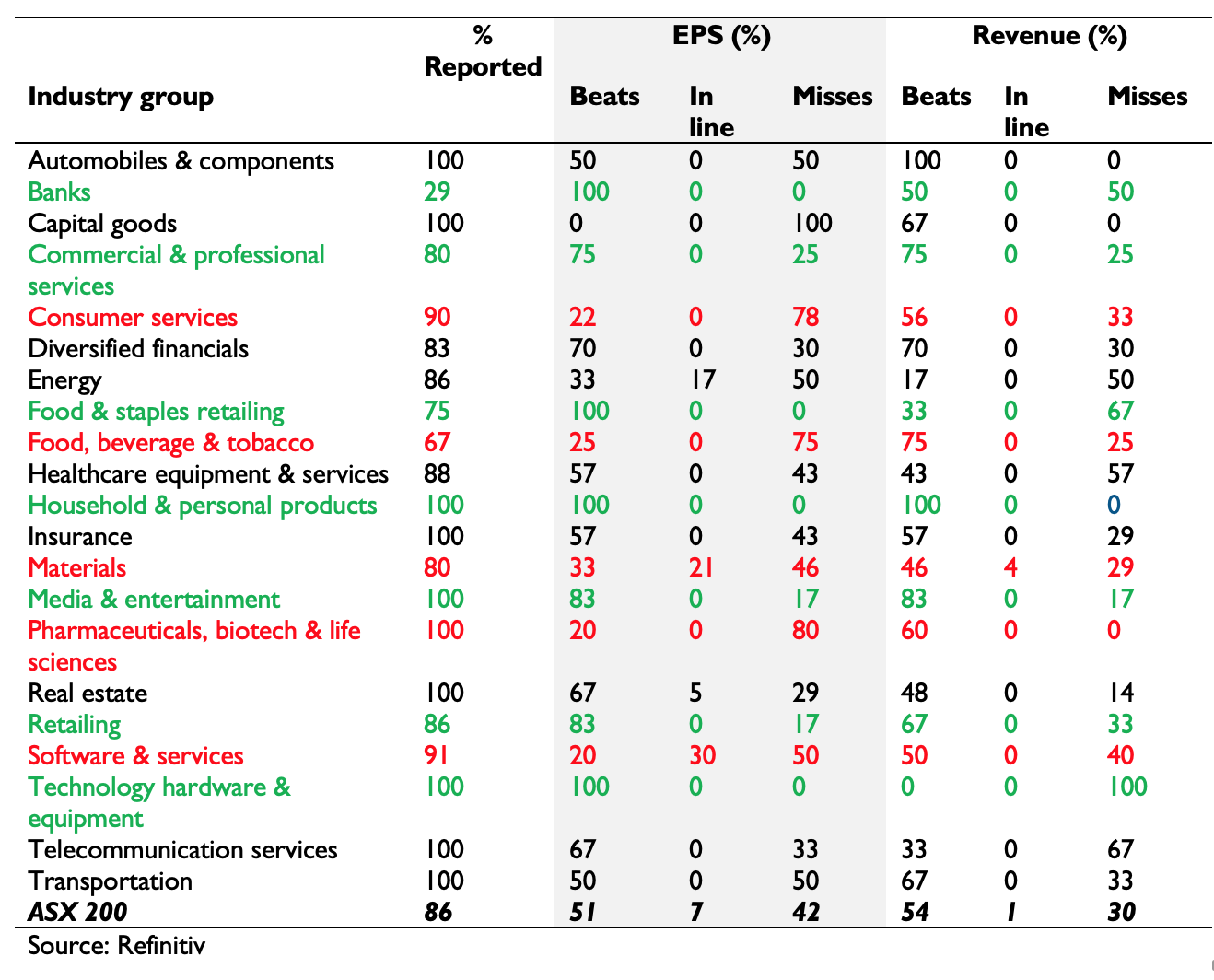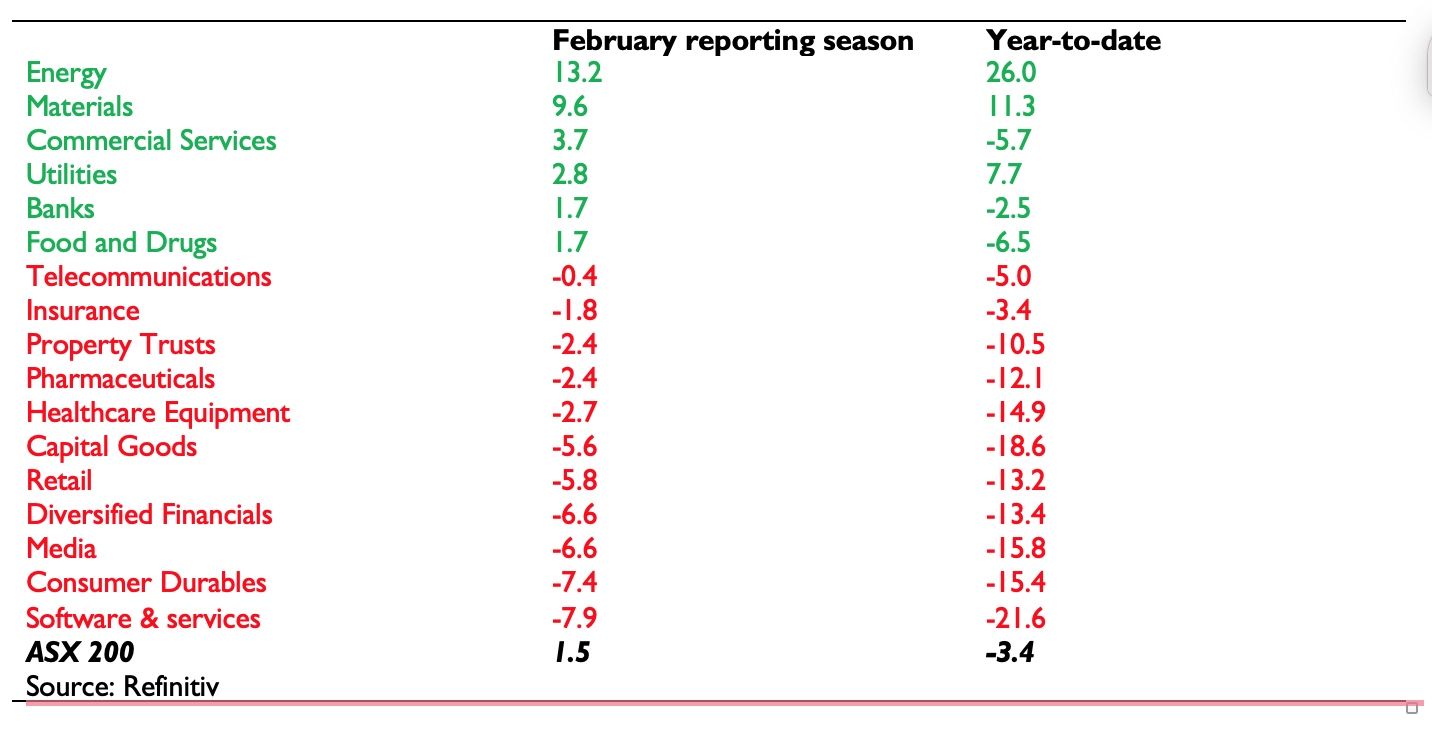ASX reporting season update: Plenty of bright spots, despite cost pressures

Foresight Analytics
Key Points
-
The ASX200’s heavy weight stocks such as BHP, RIO, CBA, and CSL all delivered positive earnings results and this provides comfort in our overweight position in the Australian market. Reporting season was generally very solid, with analysts providing a better-than-average upgrade to full-year EPS. Banks, Commercial & professional services, Food & staples retailing, Household & personal products, Media & entertainment, Retailing, and Technology, hardware & equipment all showed positive EPS surprise.
-
Macro influences such as the impact of the Russia-Ukraine war on commodity prices has been generally a positive for the commodity producers, but a negative for industrials and travel stocks. BHP and RIO lifted dividends and benefited from the strong rise in commodity prices, although other miners such as EVN and NCM higher freight and operating costs had more of an impact on the bottom line. The reopening of international borders has been a clear positive for domestic production and services, but it will take time for the benefits to ease domestic labour shortages. It is also supporting an improved outlook for travel stocks even if the war is impacting travel sentiment.
-
Cost pressures are being felt across all industries, but global industrials such as AMC and BXB are seeing more than most and have been able to push these costs onto customers. Domestic player such as QUB have also pushed on costs to customers, but labour shortages particularly in WA due to closed borders are problematic. Closer to the consumer where the inflation data shows price gains have been more subdued, SULwent about managing supply chain issues by raising inventory and this led to a drop in earnings.
- The Banks have benefitted from the strong property market, with BEN and CBA seeing above system lending growth. CSR and FBU are also seeing strong growth in volumes and are pushing through price increases and both management teams expect this to continue for the remainder of the calendar year. DHG appears to have underinvested in staff and product development to take full advantage of the strong housing market and the results were disappointing.
-
CSL, TWE and A2M are clear turnaround stories. CSL has been hit by rising costs from the pandemic, but the upgrade to earnings was welcome after 18 months of operational difficulties and the Vifor acquisition. TWE and A2M management have been able to find new markets after trade difficulties have caused havoc in the businesses.
Reporting Season: upgrades and positive surprises:
Reporting season is in the rear vision mirror, but it’s worth looking at how it tracked vs expectations. The ASX 200 saw an upgrade to full-year EPS growth of 1.1%pts vs the long-term (14-year) average of -0.2%pts, so based on this indicator reporting season was positive for investors even if the upgrade to full-year ahead EPSs growth was less than last year (Figure 1).
Figure 1: ASX 200 upgrades to full-year EPS growth

At the industry level, Insurance, Consumer durables, Retail, Media, Capital goods, Materials, Healthcare equipment, Software, Telecommunications, Utilities and property trusts all saw better-than-average upgrades to full-year EPS growth.
The industry groups seeing larger than average downgrades include: Banks, Diversified financials, Food & drugs, Consumer services, Commercial services, Transport, Energy, and Utilities.
Figure 2: Industry group full-year EPS growth upgrades

It’s also worth looking at the first-half results at the industry level. Positive surprises were broad and across several industry groups.
The positive EPS surprises were in the following industries:
- Banks, Commercial & professional services, Food & staples retailing, Household & personal products, Media & entertainment, Retailing, and Technology, hardware & equipment (Figure 1). Industries with an EPS surprise that have contained costs include Banks, Food & staples retailing, which did not appear to pass through cost pressures.
Industries with positive EPS surprises that also had positive revenue surprises were:
- Household and personal products, Commercial & professional services, Media & entertainment, and Retailing. This group of industries appear to have pricing power and have been able to pass on costs, while managing the impact of lockdowns and COVID restrictions from the Delta outbreak in H2 last year.
The industries with EPS disappointments were:
- Consumer services, Food, beverage & tobacco, Materials, Pharmaceuticals, biotech and Software.
Industries with a reasonably large number of EPS and revenue misses include:
- Energy, Healthcare equipment & services and transport saw a reasonable number of stocks disappoint on both EPS and revenue.
Figure 3: Tracking EPS and Revenue

Ukraine War Backdrop:
During our recent webinar and in our latest note on inflation we highlighted the risk of a military invasion of Ukraine by Russia. The west’s economic sanctions have proven an effective economic weapon in support of Ukraine.
We also mentioned this was a threat to our generally positive equities outlook and our bearish outlook for bonds.
The increase in inflation and expectations that the Fed will join other central banks in tightening policy has had a large impact on returns. Furthermore, the war in Ukraine remains fluid and has also impacted the performance of the market.
A good example of the impact of macro factors on reporting season is the Materials sector and impact on commodity prices from the war in Ukraine. The large diversified miners had a stellar reporting season period even if in aggregate more stocks mist expectations than beat them. The full-year upgrades to growth were very large vs history and investors have been rewarded as analysts upgraded commodity price expectations for the full year.
Energy posted a gain of 13% during reporting season on the surge in gas and oil prices, although the full year upgrades to EPS growth were weaker than past half-year reporting season periods. The sector also saw more misses than beats on both revenue and EPS.
Commercial services and Utilities performed strongly even if the analysts’ change to full-year EPS growth estimates were weaker than average. Commercial services also saw more misses than beats.
Figure 4: ASX 200 Sector Returns

Messages from Management
Managing cost pressures:
AMC announced sales rose by 12% to $US6.93bn, but management implemented $US650m of price rises across its global operations to reduce the impact on costs from a 10% increase in materials costs across the business. Organic sales increased by only 2% and this pushed the share price lower. Management said freight and logistics costs rose by 20% in some instances, while energy costs had also been rising. Guidance for the full year were unchanged, with EPS expected to show growth of 7% to 11% on a comparable, constant currency basis.
CCL continued to benefit from the pandemic with revenue increasing by 1% to $A20.7bn. The company reported a 2% fall in NPAT to $A549m for 27 weeks ended January 2 – comfortably topping analysts’ consensus forecasts of $A528m. Gross margins increased in supermarkets and liquor, despite higher COVID-19 costs which reached $150 million in the period – $45 million more than a year ago. Coles spent an additional $30 million in costs in January alone as the omicron impact peaked. Management said wage cost pressures are unlikely to abate until working holiday visa holders properly return and oil prices ease.
Another stock QUB saw a 27% increase in group revenues to $A1.2bn on the back of stronger volumes of commodities such as grain and steel moving through ports. However, transport, wage, fuel and maintenance costs also increased and NPAT fell by 2.6% to $56.3m. Patrick’s market share dropped to 42% in the December quarter compared with 44% in the June quarter. Labour shortages in WA due to its closed border also impacted QUB.
BXB warned a global pallets shortage will probably drag on for another year, after it raised prices by 8% in the half to help claw back a $US377m lift in timber costs. The company posted a 4% increase in NPAT net profit after tax to $US304.5m in the half, with revenue rising by 8% to $US2.77bn. Management lifted full-year guidance and now expects sales growth to be between 6% and 8% from a previously expected range of 5% to 7%. It expects underlying NPAT growth of 3% to 5%, up from a previous range of 1% to 2%.
Closer to the retail customer, SUL reported a surge in inventory, which it said was to combat such costly supply chain problems. That mirrored moves from toilet makers to bicycle retailers after COVID-19 disrupted logistics worldwide. NPAT fell from $A172.8 in H121 to $A110.8m in H122. However, management indicated rising costs of supply chain disruptions would probably “impact gross margin in the second half”.
Tech structural change and competition:
APX is creating a track record of disappointing the market. Underlying EBITDA rose by 3% to $US77.7m for the full year vs expectations of $US81m to $US88m. Excluding foreign exchange impacts, EBITDA rose by 12% to $US78.9m. The order book rose from $US165.7m to $US190m, but management’s decision not to set guidance caused the share price to fall. The business has been impacted by regulatory changes and Apple’s decision to allow iOS users to block the app tracking technology that underpins its advertising revenue was affecting Appen’s core customer base. This occurred when Facebook revealed it was expecting a $US1bn hit to its advertising revenue from the change.
ALU saw revenue increase by 28% to US$102m due to a strong rise in revenue from the board and systems business US$79.17m. The Europe, Middle East, and Africa segment saw revenue increase by 25% to US$23m, with China the only segment seeing sub double-digit growth. Operating cash flow rose by 33% to $US33.28m. Management indicated the full-year margin would be at the low end of its margin guidance range.
Not every tech stock has struggled. NXT saw data centre services revenue increase by 27% to $A121.6m, while underlying EBITDA rose by 29% to $A65.7m. Management indicated COVID-19 has been a positive catalyst for digital services and technology providers supported by their data centre platform.
A dividend boom for the big Miners, despite cost pressures:
BHP rewarded investors with another record dividend ($US1.50 per share). BHP recorded a 27% increase in revenue to $US33.8 bn and a 46% increase in underlying EBITDA to $US21.3bnn. The strong result was driven by strength in the iron ore business, but also record prices for coking coal and strong copper prices. Cost pressures due to supply bottlenecks are a challenge and management expected this to remain in the 2022 calendar year. RIOalso posted strong results, with the company reporting $US21.4bn of underlying earnings, the biggest in Rio’s 149-year history. Management paid investors $US4.79 per share of final and special dividends.
Gold miners such as NCM reported a fall in output at the Lahir and Cadia mines due to maintenance shutdowns and higher labour and freight costs. NPAT fell from $A553m in H121 to $A298m and COVID-related cost guidance was increased to $A50-$A60m from $A35-$A45m. EVN reported a 60% decline in NPAT to $A90.8m due lower output, higher operating costs and lower prices.
FMG lowered its interim dividend after cost pressures and discounts to its lower grade ores caused EPS to decline by 32% to $US2.77bn.
AWC announced an increase in NPAT to $US187.6m from $US146.6m last year. Management decided to pay a $US2.8 cents per share final dividend from last year’s $US2.9 cents per share payout. AWC’s AWAC asset reported an 11% increase in NPAT to $US443.8 million, due to record aluminium prices. Higher freight costs weighed on the result, with the cost of shipping alumina to China from Australia rising from around $US18 per tonne to $US50 due to COVID-19-induced, supply chain bottlenecks and disruptions.
In the Zone for Growth: Growth names see better days ahead
CSL reported a rise in revenue of 5% to $US6bn, while NPAT fell by 3% to $US1.76 bn. Competition forced the company to increase its payments to new donors for their first eight donations from around $US600 to $US1100. Its fall in H1 NPAT followed an uncharacteristic 45% surge last year to $US1.8bn. Management maintained its $US1.04 a share interim dividend from a year ago. Sentiment around the Vifor acquisition remained positive after it reported a solid result. Management reiterated CSL’s full-year guidance of NPAT between $US2.15bn and $US2.25bn, which is a decline of around 9% on FY21. But the earnings target includes the $US90m to $US110m transaction costs related to the proposed Vifor acquisition, effectively a 4% to 5% upgrade.
COH saw a 10% increase in revenue, despite hospitals in the US being well below capacity for implant surgery. Sales of Cochlear implant units rose by 7% to 18,598 units, with the bulk of the increase in emerging markets. Management maintained its full-year underlying NPAT guidance of between $US265m and $US285m.
A2M saw a 2.5% decline in revenue to $NZ660.6m that was in line with guidance, while EBITDA fell 55.3% to $NZ97.6m. The EBITDA margin was reduced to 14.8% compared to 26.4% last year. The business is responding to tough competition by increasing marketing expenditure, which is now expected to be about $NZ220m– higher than 2020 peak levels – with $NZ120m spent in H222. Reseller and Daigou activity remain weak. Despite competition, the brand health is improving, the China label is gaining share in both mother and baby stores and online; and the English label channel is improving. The opening up of the international border will also help the stock over the longer-term.
TWE saw net sales revenue fall by 10.1% to $A1,267m and net sales revenue per case rise by 16% to $A95.60. EBITS fell by 6.7% to $A262.4m and the EBITS margin increased by 0.8ppts to 20.7%. NPAT fell by 7.5% to $A109.1m. Management said its financial objective remains to deliver sustainable top-line growth and high-single digit average earnings growth over the long-term. Management said it was carefully increasing the prices of some luxury wines to claw back some of the extra $10m in supply chain costs, particularly those costs associated with New Zealand sauvignon blanc wines led by its Matua brand. Earnings from the mainland China business tumbled to just $2m compared with $78.2m a year earlier.
Turnaround Stories:
The opening of international and state borders has delivered some optimism towards travel stocks such as FLT, WEB, CTD and QAN. However, this sentiment has been tempered somewhat by the rise in oil prices and general travel concerns stemming from the escalation in the Ukraine-Russia war.
CTD’s acquisition of Helloworld's ANZ-based corporate and entertainment travel businesses was approved by the ACCC. FLT saw strong top line revenue growth, but the EBITDA loss rose by 18%, in part due to government subsidies in H121. WEB also announced it was taking a 49% stake in US hotel room upselling solutions provider (Roomdex Inc) and this was generally well received by the market.
Strong housing market:
CBA’s home loan volumes rose by 8.5% in H122 to $A40.4bn as the company’s mortgage book grew at 1.2 times system growth. The business banking division continues to turnaround, with lending volumes increasing by 12.5% or $13.2bn, as the business loan book grew 1.7 times the broader system.
There was an 8bp fall in the net interest margin from the sharp increase in the liquid assets CBA is required to hold against loans it has written and a 4bp drag from customers switching to lower-margin fixed-rate loans. CBA put the drag from price competition in variable mortgages as 3bp.
DHG reported a 27% increase in revenue to $176.2m and a 2.4% increase in NPAT to $19.5m. EBITDA rose by 14.2% to $61m. Cost management was a problem. Higher revenue means stronger demand on staffing and there was a smaller amount of targeted investment, particularly in product and technology staff, to accelerate product development.
Even agribusiness bank BEN saw solid performance in residential mortgages, which grew at 1.1 times system growth on the back of population movement to regional areas. The share of business and agri lending increased by 8.3% versus system growth of 10.6%. Competition was also strong during the half.
CSR reported a strong 167% increase in NPAT to $A157m on the back of a $A70m one-off gain from the carry-forward tax of losses stemming from the 2019 sale of the Viridian glass business. The building products division saw 25% increase in EBIT to $A121m due to strong demand in the detached market fueled by the federal government’s Home Builder scheme. Management reported shortages in bricks, gyprock, insulation and roof tiles are supporting price increases, with more to come for the remainder of the year. They said the apartment market remained weak.
FBU mentioned lockdowns in New Zealand and Australia dragged down EBIT by $NZ105m, but the company still managed to increase revenue by 2% and lift in EBIT before significant items of 3% to $NZ332m. Management said they remain on track to further improve EBIT margins across the Group to 10% in FY23 and importantly, they see a maturing pipeline of investments that will keep driving growth beyond FY23.
About Foresight Analytics
Foresight is a data-driven, investment research, analytics, and consulting firm. Foresight is not owned by any product provider or manufacturer. The firm’s business model is purely based on fee-for-service. Using its innovative, evidence-based framework, Foresight provides analytical, predictive and market intelligence solutions to leading investment management companies, superannuation funds and wealth groups. Foresight’s capabilities are underpinned by leading data and technology infrastructure that blends statistical, fundamental, and behavioural insights.
Foresight’s fiduciary solutions includes Diligence Services and Ratings (Investment, ESG, Risk and Operational Diligence), Advanced Portfolio Analytics and Strategic Research.
Foresight’s fund strategy solutions include Advanced Analytics for asset managers, Fund strategy positioning and benchmarking services, fund industry intelligence and research as well as Strategic process review, integration, and validation services.
4 topics

Shane Lee is a strategist at Foresight Analytics. He has as around 20 years’ experience in various sell-side research and asset allocation roles. He was the asset allocation analyst at ANZ wealth/IOOF for a 2-year period between 2017 and 2019....
Expertise

Shane Lee is a strategist at Foresight Analytics. He has as around 20 years’ experience in various sell-side research and asset allocation roles. He was the asset allocation analyst at ANZ wealth/IOOF for a 2-year period between 2017 and 2019....
